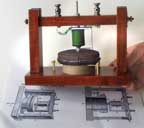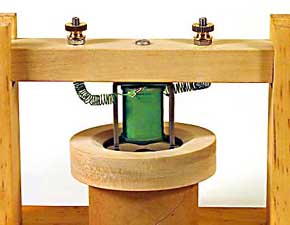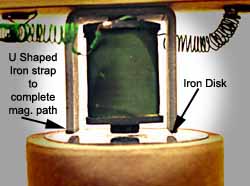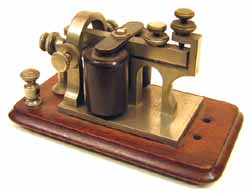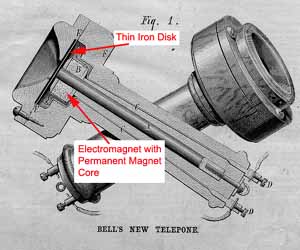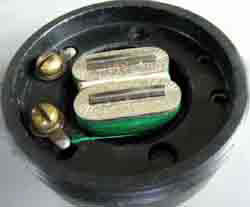-
The first telephone design that Bell had
Watson construct didn't work and was set aside for a month
-
A second version with a lighter armature, a
small metal diaphragm was made from the first set of parts plus changes.
It seemed to worked for Watson but when Bell tried it didn't work.
-
At this time Hubbard one of Bell's
financial sponsors interfered and discourage Bell in any further work on the telephone
until he had finished with other inventions.
-
Should Bell apply for a patent
with this "questionable" level of verification?
-
Bell decides with these questionable results
and without any further improvements
or experiments to go ahead and apply for a patent!
-
8 months later! March 7 1876 Bell was issued patent 174465 on the
telephone.
-
Within days after the patent was awarded Bell
goes back to the lab to make his telephone work!
-
But even then did it work?
-
IT sort of did, at least for relatively small
distances.
-
-
It took the work of Edison with his carbon transmitter
and induction coil to make telephone work over commercial and domestic distances.
-
So in the end only after Bell's patent covering
the magnet receiver was married to Thomas's Edison's patent covering the
carbon microphone and induction coil 1878 did the telephone really
became the "TELEPHONE".
-
-
Another interesting tidbit, during this
time in late November 1877 Edison invented his phonograph.
-
What would it have taken to make one work
before the patent application?
-
We critiqued the design then built one with
out the weakness Bell had in his model.
-
We copied most of the parts used in Bells 1st
design. We did not use the membrane but added a
thin soft iron disk and
a permanent magnetic field to the core. We used the same frame.
-
The instrument we built is compared with Bells
in the pictures shown below. It took less than three hours of shop time
and it worked. Our Gallows telephone design used fewer parts with
the same mechanical layout in Bell's design, but we made sure that the
magnetic field was much more concentrated.
-
We found that there were minimal design
and shop work changes to build a
suitable demonstration instrument for sending speech over wires.
-
Why didn't Bell use this
design in the first place? He used it later. Why did he the get the
patent?
-
-
The most probable answers?
-
1st Technical:
-
Bell apparently did not
understand the management of magnetic
fields around electromagnets nor simple electrical laws of
electromagnetism
even thou there
were working examples around him that he was handling nearly every day which
included the features he needed for a successful telephone.
-
For example he had telegraph relays and sounders all which were designed with the efficient
treatment of magnetic fields, a thing
that he definite lacked in his earliest design.
Perhaps the patent office was not aware of
this.
-
-
2nd Political:
-
As to getting the patent
with so little to no confirming tests results. This is very difficult to ascertain. We find from our literature search,
suggestions with very little proof, that there were many
questionable activities going on in the background at the patent office
between sponsors, lawyers, inventors, and patent staff.
-
-
Another good question to
ask.
-
How do inventors make their
inventions work ? and did Bell do things differently?
-
Most scientist and inventers
work along the same route, that is they gather the work
and discoveries of others and try this and that until something clicks
almost by accident. I have seen and been apart of groups of
scientist engineers working on the same problem when this CLICK
happens! It happens to almost every member of the team within a
second or two of each other, certainly within a few days.
-
-
Bell like most inventors made
use of and built on
other peoples ideas to create a design that ultimately worked. The
question then we must ask is. Who, of these others, should
have been included on the patent?
-
-
Bell certainly was working
in a group, not always in a legal contract group but a group
nevertheless. He was communicating with Henry (one of American greatest
scientist on magnetism) other telegraph inventors, people at Williams's
shop who were working on all sorts of telegraph ideas, Watson who was
constantly going to library looking at the scientific and engineering
literature.
-
So who gets the prize for
this invention? The one who talks or writes the fastest and gets
the idea out on the table first ? Or is it the one in control like a
leader? In this instance Bell was the tech leader and its well documented
the Watson was a very active contributor.
-
-
Now after looking at the
perspective described above, was
Bell really the inventor of the telephone? Again when he submitted
his application he did not have proof that his invention worked. We
built, for this project, an instrument to get this proof. It was
easy to design and build. We used parts that were readily available to
Bell. A good question is why didn't Bell use this or a similar
design for his first instrument? ironically shortly after he
received his patent he did use this design and presented it at the
Centennially Celebration in Philadelphia.
-
-
In the end the courts decided that Bell
was the inventor and some would say 'That that".
-
But one could rebut,
that few if any judges, lawyers,
or juries understood enough about the scientific principles that
one needs to make this judgment.
-
So it could be that Bell
was awarded the patent because
the system didn't have the skill set to make the correct judgment?
-
Or could it be that he
was the inventor with the most and best lawyers and no one at the time
really cared to go to the expense of getting the patent reversed.
-
-
From this story perhaps we should be
asking ourselves about
the present patent and scientific award systems. They are
very much the same today as in Bell's time.
-
We haven't done much
about recognizing the TEAM effort?
Each team member may be in different part of the world and communicate by
word of mouth, writing, telegraph, telephone, internet, etc etc and the
communications maybe years months days hours or second apart but
they all contribute.
Discoveries and inventions
are always through group efforts.
-
-
Why is it so
necessary for some Homo sapiens to continue their search for
-
"THE INVENTOR, THE SCIENTIST" ?

